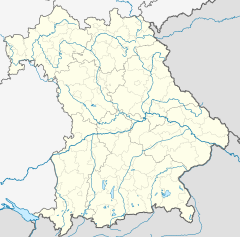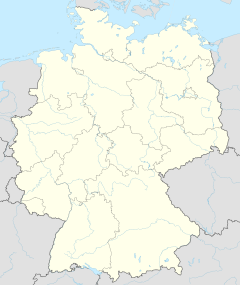Befreiungshalle
You can help expand this article with text translated from the corresponding article in German. (March 2019) Click [show] for important translation instructions.
|
| Befreiungshalle | |
|---|---|
 Befreiungshalle Kelheim | |
 | |
| General information | |
| Architectural style | Neoclassical |
| Town or city | Kelheim |
| Country | Germany |
| Coordinates | 48°55′06″N 11°51′38″E / 48.91833°N 11.86056°E |
| Client | King Ludwig I of Bavaria |
| Owner | Bavarian Administration of State-Owned Palaces, Gardens and Lakes |
| Design and construction | |
| Architect(s) | Friedrich von Gärtner, Leo von Klenze |
| Designations | Baudenkmal (listed monument) |
The Befreiungshalle ("Hall of Liberation", German:
History


King
The construction was started in 1842 by
The following dictum by King Ludwig I, embedded into the marble floor, commemorates the occasion of the construction of the Befreiungshalle:
MOECHTEN |
May |
This inscription of dedication is to be found above the ornamented door frame of the entrance portal:
DEN TEUTSCHEN |
To the German |
For the celebration of the first stone laying on 19 October Ludwig I had a poem written dedicated to the soldiers who had fought in the Napoleonic Wars. Joseph Hartmann Stutz had set it to music:[1]
| German | English |
|---|---|
1. Heil Euch, wack’re Männer, muth’ge Krieger, |
1. Hail to you, valiant men, brave warriors |
2. Dumpf und finster hatt es uns umgeben, |
2. We were surrounded by dull and dark forces, |
3. Dass die Zwietracht schmählich uns gekettet, |
3. We will never forget |
4. Durch der Zeiten weite Ferne schlinge |
4. May forever wind |
Today
The hall, including the upper exterior gallery, is open to the public.[2]
Architecture
The powerful-looking rotunda made of Kelheim limestone rests on a three-tier base, which is designed as an octadecagon. The outer facade is divided by 18 pillars with 18 colossal statues by Johann Halbig as allegories of the German tribes that took part in the battles. These are: "Franconian, Bohemian, Tyrolean, Bavarian, Austrian, Prussian, Hanoverian, Moravian, Saxony, Silesian, Brandenburger, Pomeranian, Mecklenburg, Westphalia, Hesse, Thuringian, Rhinelander, Swabia" (circulating in this order with an arbitrary start) .
The round hall has a height of 45 metres (148 ft) and a diameter of 29 metres (95 ft). Its interior is illuminated by a dome. The inner gallery can be reached via 82 steps. Another 40 steps lead to the outer viewing terrace, from which one has a wide view of the
The interior of the hall is designed as a large domed hall, which is lit by an
The obvious preference for the number 18 is due to the fact that both the Battle of Leipzig and the Battle of Waterloo took place on an 18th day of the month. It can also be found in the number of 54 columns and 54 pillars (3 × 18), in the twice 36 columns in the upper gallery (2 × 18) and in the inscriptions for 18 generals and recaptured fortresses.
See also
- Völkerschlachtdenkmal (Monument to the Battle of the Nations, Leipzig, Germany)
- Walhalla temple(Hall of the Slain, Regensburg, Germany)
- Ruhmeshalle (Hall of Fame, Munich, Germany)
- Heldenberg Memorial (in Austria)
- Prussian National Monument for the Liberation Wars, Berlin, Germany
References
- ^ The song on the website of the Bavarian administration for public castles, gardens and lakes.
- ^ Aniol, Bayerische Verwaltung der staatlichen Schlösser, Gärten und Seen, Thomas. "Bavarian Palace Department - Palaces - Hall of Liberation at Kelheim". Retrieved 19 November 2023.
{{cite web}}: CS1 maint: multiple names: authors list (link)
External links
- Official Website
- Befreiungshalle – Photos


